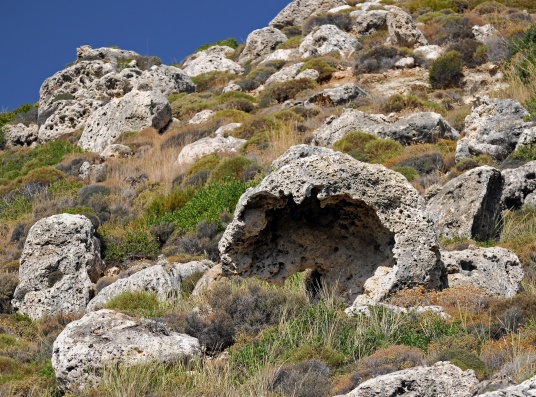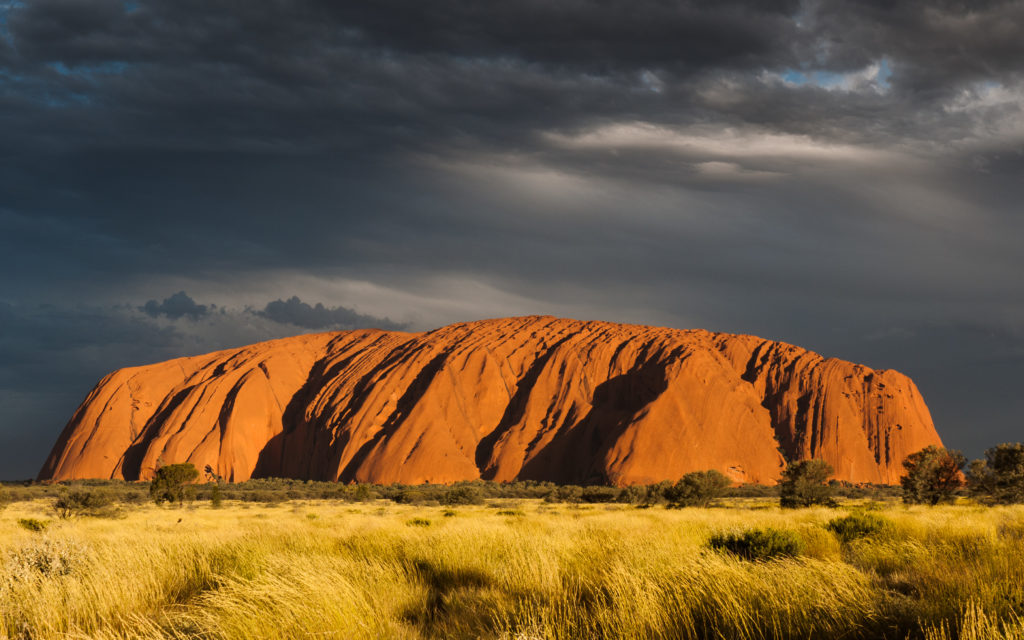Main Body
Chapter 14
Topic 13 – Weathering
Tectonics and volcanic activity have the potential to uplift or form rock at the surface of the lithospheric crust. Processes like these, that occur largely within the crust to build landscapes, are referred to as endogenous forces. At the surface of the Earth, a set of other processes is at work, balancing the uplift and formation of new rock to create equilibrium in the landscape. These external processes are called exogenous forces. Together these two sets of forces produce the landscapes and landforms that define the Earth’s surface, and they are studied in the science of geomorphology.
The rock cycle depends not only on the formation of new rock, but also the breakdown of existing rock. The part of the rock cycle focused on disintegrating rock and transporting it away from its source is called denudation. The first stage in denudation occurs when rock is exposed at or near the surface of the lithospheric crust, it begins to break down through several types of processes collectively termed weathering.

Taking advantage of pre-existing weakness in rock structure, weathering may affect the physical and chemical characteristics of the rock, with the overall effect of reducing rock strength, leading to its breakdown. This breakdown is significant not only for the rock cycle, but also for many other biogeochemical cycles as it presents an opportunity for the transfer of minerals normally found in rocks to the hydrologic cycle and from there into many other systems. For example, as precipitation falls over a rock surface it can dissolve the minerals within the rock and the runoff may carry them away to a new environment where to be used by the systems there. Furthermore, the continued development of healthy soils is heavily dependent on the provision of rock fragments and minerals generated through weathering processes. For further explanation on the types of weathering, see: https://www.geolsoc.org.uk/ks3/gsl/education/resources/rockcycle/page3461.html
There are two main categories of weathering:
- Physical (also called ‘mechanical’) weathering
- Rock breakdown occurs without chemical alteration to rock material
- Chemical weathering
- Rock structure is decomposed through chemical reactions
Primary types of physical weathering include:
- Frost wedging
- Salt weathering
- Exfoliation
- Root expansion
All of these weathering processes are based on the expansion or contraction of materials over time, usually due to climatic influence.
Primary types of chemical weathering include:
- Dissolution
- Minerals in rock material are dissolved in running water and carried away.
- Example:

- Hydrolysis
- Hydrogen ions in water replace other elements in the minerals, weakening it.
- Example:

- Oxidation
- o Oxygen ions in water replace other elements in the minerals, weakening it.
- o Example:


In the case of chemical weathering, the new minerals formed by replacing the original materials with oxygen and hydrogen ions are generally weaker than the original minerals, leading to more rapid breakdown.
Not all rock weathers at the same rate, even in the local environment. A few key variables influence the rate at which a rock surface will weather.
- Material hardness – Some mineral types are harder than others may more easily resist weathering.
- Climate – The precipitation amounts and temperature range a rock is exposed to will influence its weathering rate.
- Water – The presence of water significantly increases the rate of weathering for all rock surfaces
- Surface area – A rock that has a greater number of joints or surface area exposed to weathering will weather faster.
- Slope aspect – The direction a slope is facing controls the amount of sunlight and daily temperature variation for the surface and can affect weathering.
- Vegetation – Vegetation cover can protect a rock surface, but root growth can also increase its weathering rate.
- Porosity/Permeability – The ability of water to efficiently move through a material or be stored in a material affects its weathering rate.
Weathering is consistently happening on surfaces all around us. Keep an eye out for weathering on the human-made infrastructure around you, and in the natural landscapes you see. It is a significant part of biogeochemical cycling and therefore represents a foundational component of healthy critical zone function. Another resource for a deeper look into chemical weathering is found here: https://teach.albion.edu/jjn10/chemical-weathering/
produced or synthesized within system (Webster)
forces having an internal cause or origin (Google)
Processes that are caused by forces from within the Earth (Kiddle)
(extra-terrestrial) forces are as a result of other bodies in space(Kiddle)
come from forces on or above the Earth's surface (Wiki)
external processes ultimately driven by the sun's energy (CState University)
The field that investigates the origin of landforms on the Earth and other planets (PhysGeo)
is the study of the nature and history of landforms and the processes which create them (DartmouthU)
is the study of landforms and landscapes and the processes that act to modify the Earth’s surface (SFU 213)
The erosion or wearing down of a landmass. (2) Removal of the vegetative cover from an area (PhysGeo)
involves the processes that cause the wearing away of the Earth's surface by moving water, by ice, by wind and by waves, leading to a reduction in elevation and in relief of landforms and of landscapes (Wiki)
is an erosive process of breaking and removing the rocks from the surface of the earth (Chegg)
Physical, chemical or biological breakdown of rocks and minerals into smaller sized particles.
breakdown of rock in situ by physical and chemical processes due to the presence of water, plants and animals (Itseducation)
is the breakdown of rocks at the Earth’s surface, by the action of rainwater, extremes of temperature, and biological activity (Geological Society)
